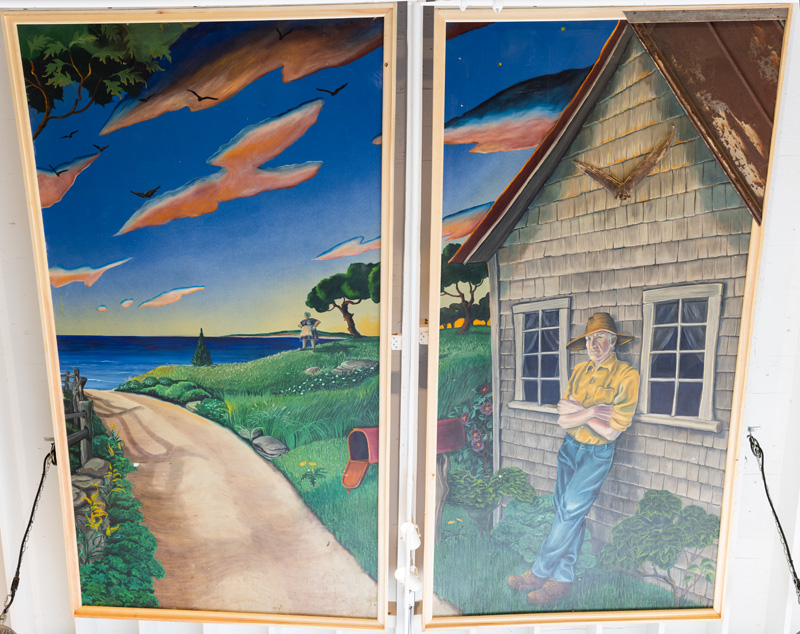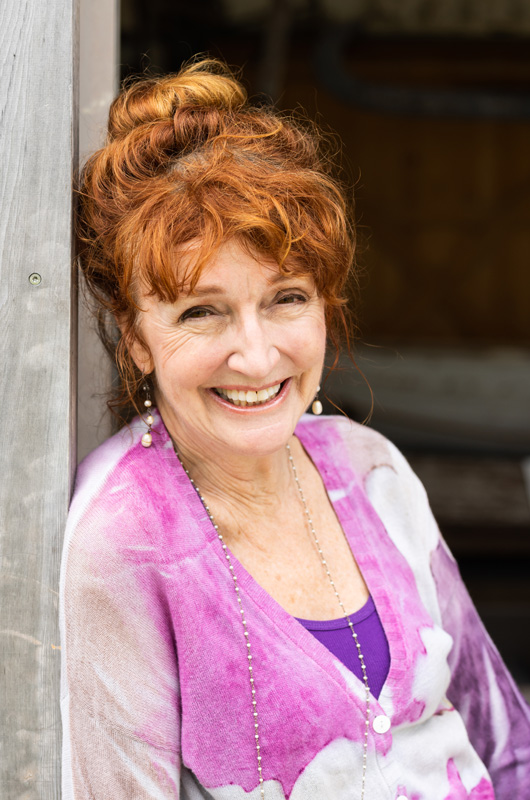For the first time in over eight years, a set of colorful Margot Datz murals from the Hot Tin Roof nightclub is seeing the light of day.
Showing scenes of Island life in a style inspired by Thomas Hart Benton, the paintings now hang on the pitched ceiling of the Martha’s Vineyard Museum’s Doherty Hall, where the museum will host a dedication and reception Thursday evening at 5:30 p.m.
“It was kind of amazing how well they held up,” said Ms. Datz, who walked with the Gazette through the hall Sunday afternoon as her seven-year-old granddaughter Georgette blew soap bubbles on the museum lawn. “They really endured.”
To the legion of fans Ms. Datz has earned over the past quarter-century, the murals offer a glimpse of her earlier work. But club-goers who remember the Hot Tin Roof may recognize the images as long-lost friends. There’s the couple dancing merrily on the beach against a Technicolor sunset, with more revelers dashing in to join the fun. Another panel shows the guests arriving by pickup truck to a warm welcome at the door of a shingled cottage.
Two other panels include what’s still Ms. Datz’s favorite of them all: the frowning farmer, arms folded and lips sealed, who meets the viewer’s eye as his wife hollers for him from a nearby hill. Unlike the other figures she painted for the Hot Tin Roof, this one was modeled on an actual Islander: Georgette’s great-great-uncle John Allan Blair of Edgartown, who died in 2003.
“I told him to scowl,” Ms. Datz said.
The images at the museum are not the murals from the original Hot Tin Roof as it opened in 1979, with interior design by Ms. Datz and fellow Island decorative painter Linda Carnegie. Inspired by the post-impressionist work of French painter Henri Rousseau, the two artists also used scrapped farm equipment and other salvage to create settings for their paintings, Ms. Datz said.
“We did the whole club for two grand [$2,000], and that included fans, mirrors, upholstery — I just threw myself at this project,” she recalled.
Club owners George Brush, the late Herb Putnam and Carly Simon gave themselves and their contractors just three months to create the original Hot Tin Roof, “from the ground up,” Ms. Datz said.
“It was this marvelous unison effort to build that dream,” she said.
“Having Carly on board was like being struck by glamour lightning. She brought this panache to the project that just launched it into another dimension,” Ms. Datz recalled.
The design job wasn’t a money-maker for the Carnegie-Datz team — “I wanted all the budget to go to the decor,” Ms. Datz said — but it opened doors on the Vineyard, where she had recently moved from New Orleans after falling for an Island fisherman.
“I think that this was the thing that sort of launched me into …recognition as an artist on Martha’s Vineyard,” she said. “I’d been a sculptor prior to that, and this moved us into a broader venue.”
There were also significant benefits to being an insider at the nightclub.
“It was fun being on the VIP list,” Ms. Datz said.
“I think that’s how I got paid, being able to cut the line,” she added, laughing. “If murals could talk!”
When the Hot Tin Roof first opened for business, it quickly became the epicenter of Martha’s Vineyard night life, attracting music-lovers of every stripe to listen and dance to live music by world-renowned performers.
“The club rocketed to national recognition,” Ms. Datz said. “You wouldn’t believe the people you saw [in the audience] … Jackie O, John Travolta, John Belushi, Billy Joel and Christie Brinkley [and] Carly, of course.”
“Like the Vineyard, it was at once very familiar and intimate, yet glitzy,” Ms. Datz said. “This was like a real get-down melting pot, where a celebrity would dance with a fisherman — and just great, great music. Legendary music.”
Cindi Lauper, Bonnie Raitt, John Hiatt and reggae artists galore were among the performers who took the Hot Tin Roof stage over the years, in return receiving an automobile hubcap hand-painted by Ms. Datz in their honor.
“I wish I knew where those hubcaps were,” she said.
The original Hot Tin Roof closed in 1986, later changing hands and remaining fallow for about 10 years until Mr. Putnam, with new partners, bought back the club and invited Ms. Datz — now an established decorative painter — to design the interior once again.
“The budget was a little bigger this time,” she said with a smile.
Instead of the French-naive style that informed the first Hot Tin Roof design, Ms. Datz’s second set of murals pays tribute to the audiences, from all walks of life, who flocked to the club in its early days.
“What I really wanted to celebrate was that sort of work-hard, play-hard American culture — the fisherman here, the farmers, the carpenters, that whole mix — and tumble it up with a little bit of that youth spark,” she said.
Her murals also honor the work of Mr. Benton, who painted in Chilmark for a half-century of summers.
“I worshiped him,” Ms. Datz said. “He embodied exactly what I was trying to capture, which was this sort of organic vitality. How could I not pay homage to him?”
Painted directly on the club’s interior walls and adorned with pieces of real roof, shingling and other construction materials, Ms. Datz’s murals endured through multiple subsequent changes in management that saw the Hot Tin Roof become Outerlands, then Nectar’s, then Flatbread before permanently closing in 2014.
They could have gone under the wrecker’s ball were it not for the building’s current owner, Brion McGroarty, who purchased the property about five years ago.
“It’s thanks to him they’re saved,” Ms. Datz said. “He went to great personal expense to have them cut off the wall and crated. They’re very, very heavy because they include the sheet rock and the two-by-fours.”
Reached by phone at his MV Wine and Spirits store Wednesday, Mr. McGroarty said he had the murals preserved for a number of reasons, starting with public relations.
“I knew the fact that we were dismantling the Hot Tin Roof was, in the music community, not a happy subject,” he said. “I really didn’t want to tick off the music community and the art community.”
Mr. McGroarty also thought he might sell the murals, but only a handful of smaller panels have changed hands. “They’re so big that even with the huge houses that we have here, they were too big,” he said.
And then there are the murals themselves, said Mr. McGroarty, who has donated them to the museum’s permanent collection.
“In the dark, they looked beautiful,” he said, recalling nights at the club. But in the daylight, he said, “they just jump at you. It’s amazing … Margot’s amazing.
“I’m glad they are where they are right now,” Mr. McGroarty said.










Comments (4)
Comments
Comment policy »